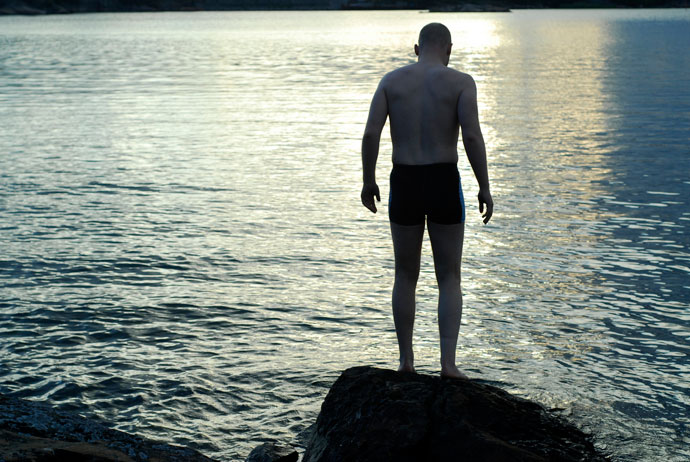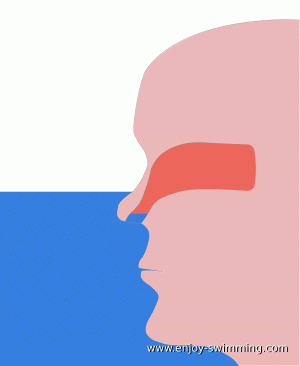Fear of water (aquaphobia) is experienced by lots of people. This article discusses this fear and proposes a few basic exercises in the water to help you overcome this fear.

Being afraid of water can be paralyzing.
Causes
Fear of water can have lots of causes:
- It often exists as an instinctive fear related to the fear of drowning.
- It can be caused by the fear of the unknown, of what might be lurking below the water surface in deep, cloudy or muddy waters.
- It may be related to a bad experience that occurred in childhood.
- It may have been transmitted to a child by parents that were themselves afraid of water.
- It may have been ingrained by swim teachers that used inadequate and/or stressful methods to teach swimming.
Putting Things Into Perspective
You don’t need to feel bad if you are subject to fear of water because everyone has a different level of water confidence and this level of water confidence can change depending on circumstances.
For example, I acquired basic swimming skills as a child and those skills have evolved with practice over the last few years since I took up swimming again. Nowadays I’m not afraid of swimming in a pool or in small to medium ponds. However, if I do swim in a lake or in the ocean, I still have a certain level of anxiety before starting, and especially so if it’s in an unfamiliar location.
The point I want to make is that even experienced swimmers can sometimes experience fear of water or at least have a certain level of anxiety.
Water Exercises – Instructions
Let’s now try to address your fear of water by doing a few basic exercises in the water. To give you the maximum level of comfort while doing these exercises, I suggest that you follow the instructions below:
All the exercises can and should be done in shallow water. There is no need for the water to go higher than your chest, so you can always feel safe.
Doing the exercises in a swimming pool with clean water is best because you can see what is (or more exactly isn’t) in the water and so you will be more relaxed than if you did the exercises in opaque water.
For the same reason it’s advisable to wear swimming goggles while doing the exercises. This way water won’t get into your eyes and you will be able to keep them open all the time, which will help you to relax.
A supportive person being at your side while doing the exercises can be of great help, and especially so if he/she is an experienced swimmer that is comfortable in the water.
If you can’t get the help of a supportive person, I recommend that you do the exercises in a swimming pool supervised by a life guard which knows what you are trying to accomplish and can keep an eye on you.
Ideally you should do the exercises when the swimming pool isn’t crowed, to avoid getting stressed out by people that splash or trash water around you.
There is no need to rush through the exercises. The main goal is to always stay comfortable. Even if you only manage to do one exercise per session at the pool, it doesn’t matter as long as you are comfortable. If you start to get stressed, slow down. Even if it takes several weeks or months for you to get through all exercises and overcome your fear of water, so be it. Think baby steps.
Acclimating To Water
To get started, we will do a few exercises for you to get comfortable being in contact with water and then entering into the water:
- At the shallow end of the pool, sit across the pool edge and let your legs dangle in the water, sweeping back and forth. Take your time to enjoy the sensation of the water flowing around your legs.
- Scoop up water with your hands and apply it to your face, as if to wash it. This is to get used to having your face being in contact with water.
- Scoop up water with your hands again, hold your breath and then splash the water into your face. As you are wearing swim goggles, your eyes are protected and you can try to keep them open. As you are holding your breath and sitting upright, you should notice that the water can’t get into your nose and mouth. Enjoy the refreshing sensation of the water on your face.
- Slowly get into the water via the steps or ladder in the shallow area of the pool. Make sure that the water doesn’t get above your chest. Walk around for some time, staying in the shallow area of the pool. Enjoy the sensation of the water flowing around your body.
Submerging Your Head
The next few exercises will let you progressively lower your head into the water until you are comfortable having your head under water. We are still (and stay) in shallow water.
- Hold your breath. Slowly crouch down until your lips are just above the water surface. How does it feel? See if you can get comfortable with having the water so close to your lips. Then stand up.
- Hold your breath. Slowly crouch down (with mouth closed) and see if you can get your mouth under water, having the water surface being between your mouth and your nose. Notice that water can’t get into your mouth.
- After a while, notice that your nose is still above the water surface. If the water is calm and there are no waves, try to breathe through your nose while still having your mouth under water. Notice that you can breathe through your nose even though your mouth is under water. Then stand up. Repeat this often to get comfortable breathing with your nose being so close to the water surface.
- Hold your breath. Slowly crouch down until your mouth touches the water surface, then goes under water. Crouch some more until your nostrils touch the water surface. If possible, hold this position for a few seconds, then stand up to breathe.
- What you need to know at this point is that it is completely ok to have water touching your nostrils or even having some water getting into your nostrils, as long as you are holding your breath and your head is upright. Because of the way the nose connects with the head, water can’t rise high enough in your nose to get into sinuses in that position. It’s only when the water gets into the sinuses that it becomes unpleasant. In fact, once you’ll have become an experienced swimmer, you will have water flowing into and out of your nostrils each stroke cycle, without ever having water getting into your sinuses and with you barely noticing.

Having some water in the nostrils is in fact ok.
- Let’s get back to our exercises. Again hold your breath, then crouch down until your nose is under water, the water surface being between your nose and your eyes. Your ears should not be under water, so slightly tilt your head forward. Again, notice how some water gets into your nostrils, but at the same time notice that it doesn’t rise very high in your nose and that because of this it doesn’t hurt. Try to hold this position a few seconds, then stand up to breathe.
- Hold your breath. Slowly crouch down as before. Now tilt your head slightly backwards. Slowly move down until your nose and your ears are below the water surface but your eyes are still above the water surface. Because you are holding your breath no water can get into your mouth and only a little bit of water gets into your nose. Notice how water gets into your ears and your hearing becomes muffled. Again try to hold this position a few seconds before standing up.
- Now what you need to know at this point is that some water will get into your ears. But this is also ok because the water will be prevented from going further by the ear drum and will flow out of the ear as soon as you leave the water. So you can’t get hurt.
- Hold your breath. Now slowly crouch down and let the water cover your mouth, nose, ears and move further down up to the point where your eyes move below the water surface. As you are wearing swim goggles (hopefully good ones), water can’t get into your eyes. Try to hold this position a few seconds, then stand up again and breathe. Once you are comfortable with your eyes below the water surface and can keep your eyes open, take the time to observe this strange world below the water surface that opens up to you.
- Once you are comfortable doing the previous exercise, you can add up the ante a little bit and do a bobbing motion, where you rhythmically submerge and emerge your head. This will get you used to having your head being submerged regularly, which will be useful later on whenlearning how to swim the popular swimming strokes.
Blowing Bubbles
Once you are comfortable having your head under water, the next step to overcome your fear of water is to learn that it is possible to exhale in the water without getting water into your nose and mouth. The best exercise for this is to learn how to blow bubbles.
- Breathe in while standing in the shallow area of the pool and hold your breath. Then crouch down so that your mouth is below the water surface but your nose is still above the water surface. Slowly exhale through your mouth, blowing bubbles in the water. You will realize that as long as you do exhale, water can’t get into your mouth. The same is true if you do hold your breath. Stand up again to breathe in.
- Repeat the previous exercise but now crouch down so far that only your eyes are above the water surface while your nose and mouth are below the water surface. Keep your mouth shut and now slowly blow bubbles through your nose. Again you will notice that water can’t get into your nose as long as you hold your breath or exhale. Stand up to breathe.
- Repeat the previous exercise but now blow bubbles in the water through both your nose and mouth.
- Finally repeat the previous exercise but with your head completely under water.
Conclusion
You should now be comfortable getting your head under water and exhaling in the water. Congratulations! These are two big steps towards losing your fear of water.
In the next part of this article, you will discover that it is in fact very easy to float in the water without much effort. So head over to part 2 of this article to continue reading.
Resource: enjoy-swimming.com
Không có nhận xét nào:
Đăng nhận xét